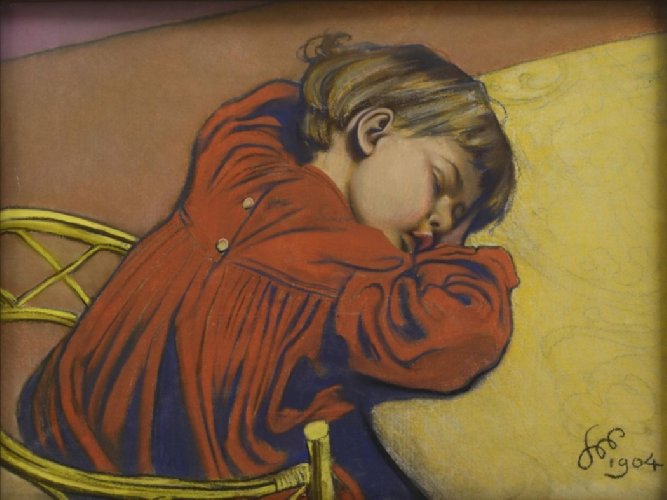Description:
Stanisław Wyspiański (1869-1907) had a great influence on the formation of an original and recognizable style of art. His studies in Krakow with Jan Matejko, his travels, and his several-year stay in Paris with his friend Józef Mehoffer had a big hand in it. He was especially impressed by the works of Van Gogh, Gauguin, and Toulouse-Lautrec in Paris. Allergic to oil paint, he began to use mainly pastels. In addition to painting, he was involved in graphic arts, decorative polychromes, stained glass window designs, theatrical productions, interior design, furniture, and poetry and drama writing. His art, which fits into the program of the Young Poland, is described as symbolic, expressionist, and secessionist.
Description of the painting:
“I’m drawing Stasiu on the table,” Wyspiański noted in his calendar on December 6, 1904. On long, winter evenings, when the children were falling asleep in different places of the Krowoderska house, Wyspiański took his pastels and immortalized one of them. Although the portraits were created quickly, the artist liked to observe his models for longer, which was often reflected in the faces of the portrayed with a slight boredom or irritation, which the children, and especially Wyspiański’s children, did not hide at all. His idea of creating peaceful images of small models was to wait until they fell asleep.
We see three-year-old Stas in a large, red dress, seated in a round wicker chair and a wooden table, on which he rested his elbows. His face is resting in his hands, and seen from a half-profile the round face with slightly parted, prominent lips is immersed in a deep sleep. The boy’s head is adorned with a blond hairstyle of straight, evenly cut hair, only one lock over his neck has mischievously curled.
As was his custom, Wyspiański narrowed the composition to a minimum, creating an intimate, chamber atmosphere. In contrast to many other portraits in which the background is dark and vague, this one shows a bright room, undoubtedly Wyspiański’s “pansy” salon. Although seemingly an unplanned, observed domestic situation, the colour scheme of the painting is carefully worked out. The pink walls and light brown floor contrast well with the red of the dress and the yellows of the chair and the table. The warm colours are balanced by the deep navy shade filling the folds of Stas’s clothing.
Wyspiański often depicted the images of his closest ones. From getting to know Teodora Teo-fila Pytko, coming from the village of Konary near Tarnow, among the great projects there also appear images of his beloved in colorful, folk costumes, as well as intimate ones, depicting her breastfeeding. Over time, Wyspiański began to capture the images of his own children, already without their mother’s arms, usually in pastel on paper. From the dozens of paintings, sleepy, bored, and sometimes even sulky kids look out, painted with a fatherly sensitivity and tenderness.


